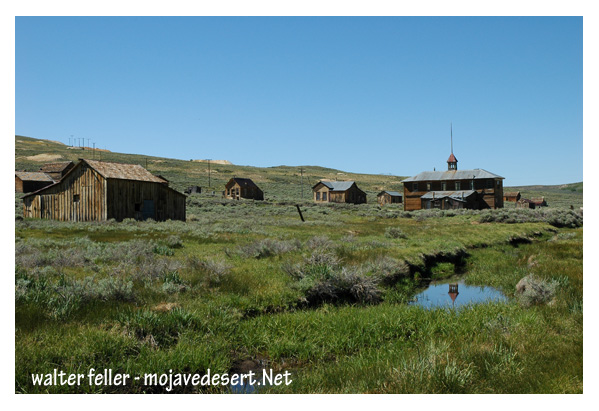Bodie is often used as a model ghost town for the Mojave Desert region, even though it lies north of it, in the Sierra Nevada–Great Basin transition zone, because it embodies the same historical, environmental, and cultural forces that shaped Mojave ghost towns. In short, Bodie represents the type, even if not the place.

Here’s why:
1. Mining Boom and Bust Pattern
Bodie’s rise and fall followed the same pattern as Mojave mining towns like Calico, Rhyolite, and Skidoo. A rich ore discovery in 1859 triggered a rush, creating a town of thousands almost overnight. When the mines declined in the 1880s and 1890s, the population vanished just as quickly. That boom-and-bust cycle defines the Mojave’s mining history as well.
2. Harsh, Isolated Environment
Although Bodie sits at a higher elevation and experiences freezing winters rather than desert heat, it shares the same frontier isolation—extreme weather, scarce water, and rugged terrain. Like the Mojave, survival there depended on resourcefulness and imported supplies.
3. Architectural and Material Similarities
The wood-frame, false-front buildings, stamp mills, and corrugated-iron roofs in Bodie are identical in style and function to those found in Mojave towns such as Ballarat or Randsburg. These towns employed similar construction methods and materials, which were hauled in by wagon or rail.
4. Cultural Reflection of the Mining West
Bodie’s lawlessness, saloons, and transient population mirror the social life of Mojave towns. Newspapers, dance halls, and miners’ unions appeared rapidly, then disappeared when the ore played out.
5. Preservation and Interpretation
Bodie is one of the best-preserved ghost towns in the American West—maintained in a state of “arrested decay.” Because of this, it serves as a tangible reference point for understanding less intact Mojave sites. It shows what Calico or Goldfield might have looked like before time and scavengers took their toll.
So, even though it’s geographically outside the Mojave Desert, Bodie stands as an ideal representative of the region’s mining-era ghost towns—capturing their architecture, atmosphere, and transient human story better than almost anywhere else.
-.-